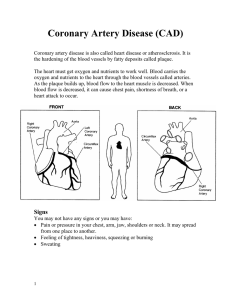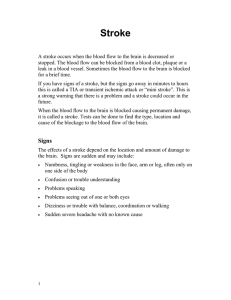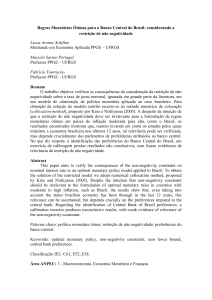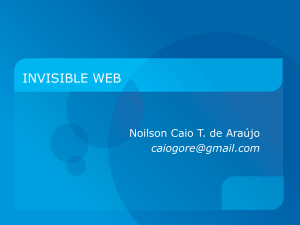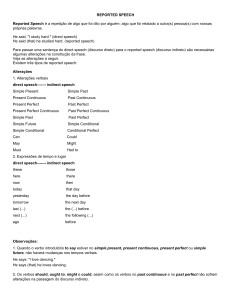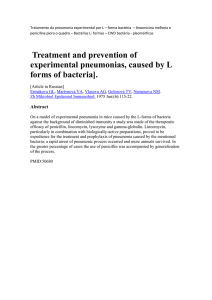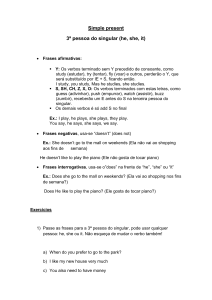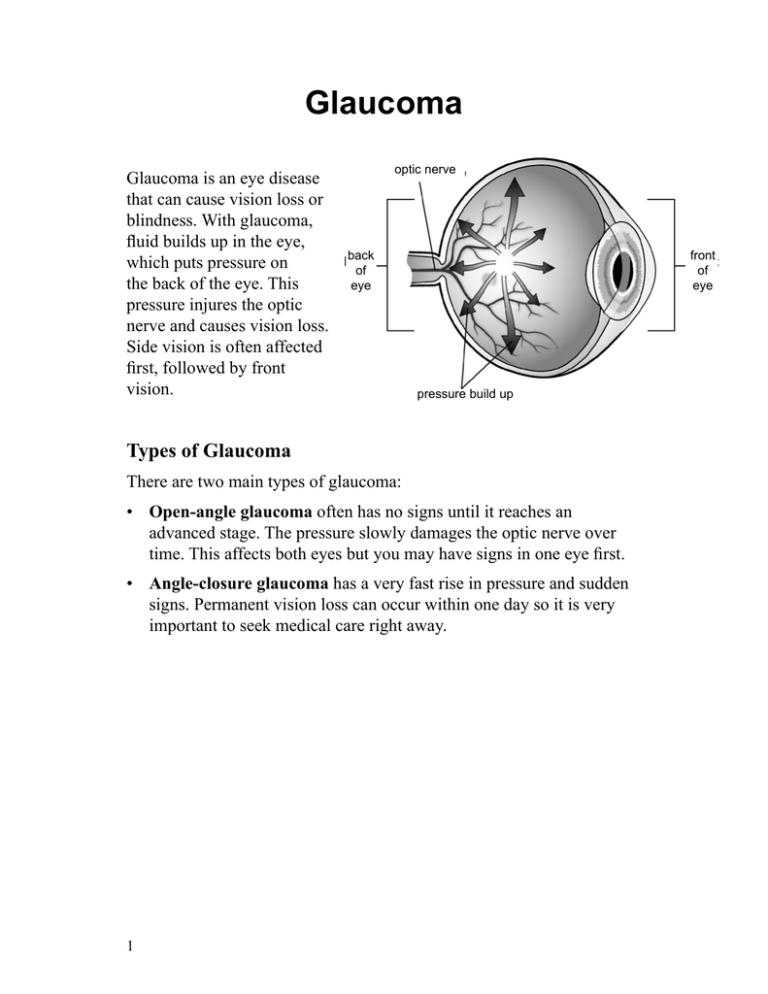
Glaucoma
Glaucoma is an eye disease
that can cause vision loss or
blindness. With glaucoma,
fluid builds up in the eye,
which puts pressure on
the back of the eye. This
pressure injures the optic
nerve and causes vision loss.
Side vision is often affected
first, followed by front
vision.
optic nerve
back
of
eye
front
of
eye
pressure build up
Types of Glaucoma
There are two main types of glaucoma:
• Open-angle glaucoma often has no signs until it reaches an
advanced stage. The pressure slowly damages the optic nerve over
time. This affects both eyes but you may have signs in one eye first.
• Angle-closure glaucoma has a very fast rise in pressure and sudden
signs. Permanent vision loss can occur within one day so it is very
important to seek medical care right away.
1
Glaucoma
O glaucoma é uma doença
ocular que pode causar
perda visual ou cegueira.
No glaucoma ocorre
acúmulo de fluido no olho
fazendo com que a pressão
intraocular aumente. Essa
pressão provoca danos ao
nervo óptico e causa perda
visual. A visão periférica
é normalmente afetada em
primeiro lugar, seguida da
visão frontal.
O nervo óptico
Parte da
frente
do olho
Parte
de trás
do olho
Aumento da pressão
Tipos de glaucoma
Existem dois tipos principais de glaucoma:
• Glaucoma de ângulo aberto – nesse tipo de glaucoma, os sinais
normalmente não são percebidos até que a doença esteja em estágio
avançado. A pressão danifica lentamente o nervo óptico com o passar
do tempo. O glaucoma afeta os dois olhos, mas os sinais podem ser
observados primeiro em apenas um olho.
• Glaucoma de ângulo fechado – nesse tipo de glaucoma, a pressão
aumenta muito rápido e os sinais aparecem repentinamente. Pode
ocorrer perda permanente da visão em apenas um dia, portanto, é
muito importante procurar tratamento médico imediatamente.
Glaucoma. Portuguese.
1
Risk Factors
You are at risk for developing glaucoma if you:
• Have a family member with glaucoma
• Have diabetes, high blood pressure, heart disease or hypothyroidism
• Are nearsighted
• Have had an injury to the eye, certain eye surgeries or chronic eye
inflammation
• Have been taking steroids for long periods of time
• Are over age 60
• Are African-American or Mexican-American
• Are of Asian-American descent – this puts you at increased risk for
angle-closure glaucoma
Signs
Glaucoma may have no signs until there is vision loss. Other signs you
may have:
• Blurred vision
• Halos around lights
• Loss of peripheral or side vision
• Tunnel vision
• Red eyes
• Severe eye pain
• Nausea and vomiting
2
Fatores de risco
Você corre risco de desenvolver glaucoma se:
• Algum membro de sua família tiver glaucoma
• Tiver diabetes, hipertensão, doença cardíaca ou hipotireoidismo
• Tiver miopia
• Tiver alguma lesão ocular, inflamação ocular crônica ou tiver sido
submetido a determinadas cirurgias oculares
• Ter tomado esteróides por longos períodos de tempo
• Tiver mais de 60 anos de idade
• For afro-americano ou mexicano-americano
• For descendente de asiáticos-americanos – entre os quais o risco de
glaucoma de ângulo fechado é maior
Sinais
O glaucoma pode não apresentar sinais até que ocorra perda visual.
Outros sinais do glaucoma:
• Visão turva
• Círculos luminosos ao redor de luzes
• Perda da visão periférica ou lateral
• Visão em túnel (estreitamento do campo visual)
• Olhos vermelhos
• Dor intensa no olho
• Náuseas e vômitos
Glaucoma. Portuguese.
2
Treatment
Your eye doctor may do tests to check your:
• Eye pressure
• Optic nerve
• Vision
Glaucoma cannot be cured and damage cannot be reversed. But with
treatment, eye pressure can be decreased and further vision loss can
be prevented. Eye drops are the most common early treatment for
glaucoma. Other treatments may include oral medicines, laser treatment
or surgery. When you have glaucoma, it must be treated for the rest of
your life.
Your Care
There is no proven way to prevent glaucoma. If increased eye pressure
is detected and treated early, it can decrease loss of vision and prevent
blindness.
• Have your eyes checked and tested for glaucoma at least every five
years after age 40. If your pressure readings begin to rise, you will
need to have eye exams more often.
• To prevent increased pressure in your eyes:
3
ff
Find ways to cope with stress.
ff
Exercise regularly.
ff
Limit caffeine.
ff
Eat a healthy diet of fruits and vegetables.
ff
Wear eye protection during work or with sports to prevent injury.
Tratamento
O médico poderá pedir exames para verificar:
• A pressão ocular
• O nervo óptico
• A visão
O glaucoma não tem cura e não é possível reverter os danos ocorridos.
Mas com o tratamento, é possível reduzir a pressão ocular e prevenir
a perda posterior da visão. O tratamento inicial mais comum para o
glaucoma é feito com colírios. Outros tratamentos podem incluir a
administração de medicamentos por via oral, tratamento com laser ou
cirurgia. O glaucoma precisa ser tratado durante toda a sua vida.
Tratamento
Não existe uma maneira comprovada de prevenir o glaucoma. Se o
aumento da pressão intraocular for detectado e tratado precocemente, é
possível reduzir a perda visual e prevenir a cegueira.
• Faça um exame para detecção de glaucoma pelo menos a cada 5
anos depois dos 40 anos de idade. Exames oftalmológicos devem
ser realizados com maior frequência em caso de aumento na pressão
intraocular.
• Para prevenir o aumento da pressão intraocular:
ff
Encontre maneiras de lidar com o estresse.
ff
Exercite-se regularmente.
ff
Limite o consumo de cafeína.
ff
Consuma uma dieta saudável à base de frutas e vegetais.
ff
Use proteção nos olhos para trabalhar ou praticar esportes para
evitar lesões.
Glaucoma. Portuguese.
3
• Control your diabetes, high blood pressure, cholesterol and heart
disease.
• Do not use herbal remedies that are advertised for glaucoma
treatment. These are not proven effective and may delay your getting
proper treatment.
Talk to your doctor or nurse if you have any questions or concerns.
2007 – 11/2011 Health Information Translations
Unless otherwise stated, user may print or download information from www.healthinfotranslations.org for personal, non-commercial use only. The medical information
found on this website should not be used in place of a consultation with your doctor or other health care provider. You should always seek the advice of your doctor or
other qualified health care provider before you start or stop any treatment or with any questions you may have about a medical condition. The Ohio State University
Medical Center, Mount Carmel Health System, OhioHealth and Nationwide Children’s Hospital are not responsible for injuries or damages you may incur as a result of
your stopping medical treatment or your failure to obtain medical treatment.
4
• Controle o diabetes, a hipertensão, o colesterol e as doenças
cardíacas.
• Não use remédios à base de ervas que são anunciados para
o tratamento do glaucoma. A eficácia desses remédios não é
comprovada e pode fazer com que você demore a obter o tratamento
adequado.
Converse com seu médico ou enfermeira em caso de dúvidas ou
preocupações.
2007 – 11/2011 Health Information Translations
Unless otherwise stated, user may print or download information from www.healthinfotranslations.org for personal, non-commercial use only. The medical information
found on this website should not be used in place of a consultation with your doctor or other health care provider. You should always seek the advice of your doctor or
other qualified health care provider before you start or stop any treatment or with any questions you may have about a medical condition. The Ohio State University
Medical Center, Mount Carmel Health System, OhioHealth and Nationwide Children’s Hospital are not responsible for injuries or damages you may incur as a result of
your stopping medical treatment or your failure to obtain medical treatment.
Glaucoma. Portuguese.
4


